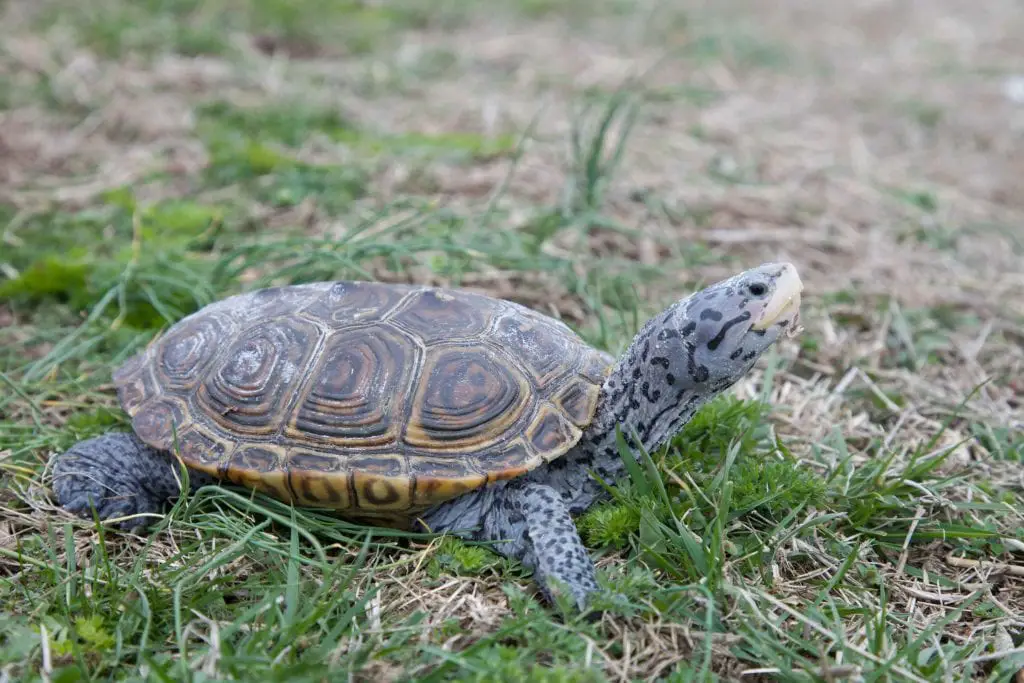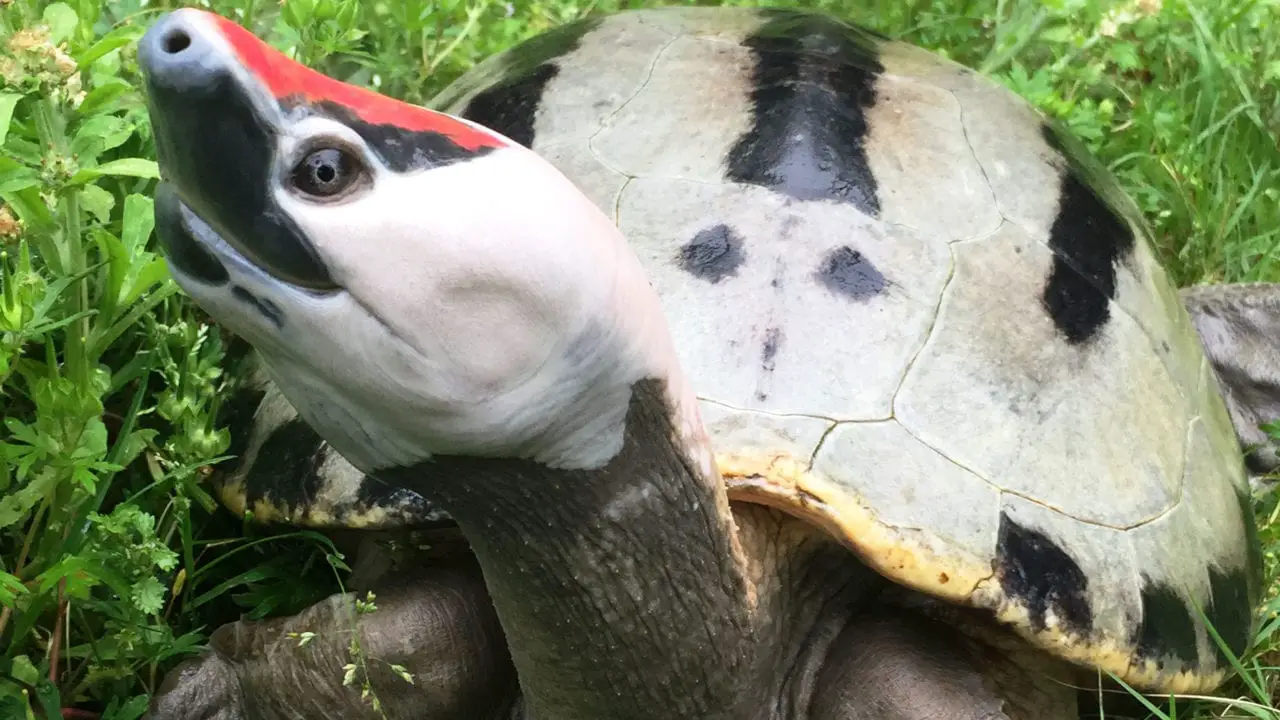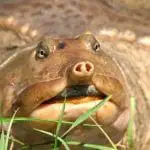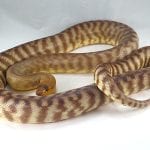Scientific Facts
| Common Name: | Painted Terrapin Turtle |
| Scientific Name: | Batagur borneoensis |
| Diet: | Herbivorous |
| Average Length: | 50cm+ |
| Lifestyle: | Aquatic |
| Reproduction: | oviparous / egg-laying |
| Status: | Critically endangered |
Facts About Painted Terrapins
The painted terrapin’s biological name is Batagur borneoensis. This is also called as painted batagur or saw-jawed turtle. They are mostly found in Malaysia, Thailand, Brunie, and Indonesia.
Batagurs cannot discharge salt coming from their bodies, so they can only live in water, having low salinity levels like the brackish and freshwater. They lay only ten to twelve eggs.
Species

Batagur affinis
It includes two subspecies: B. a. affinis, B. a. edwardmolli. This came from Cambodia. There it was endangered, but in 2001 it was rediscovered.
Batagur baska
It is under extinction in Myanmar, Singapore, Vietnam, and Thailand. It is found rarely in Indonesia, Malaysia’s mangroves. Terengganu River is the nesting place for this species.
Batagur dhongoka
The shell of this species is similar to B. borneoensis. It is found in Bangladesh and some parts of India.
Batagur kachuga
This was known as Kachuga, kachuga. It is mostly found in the Northern part of India. The population is now becoming limited.
Batagur trivittata
It was formerly called as Kachuga trivittata. It is very rare and endemic in Myanmar. It was once extinct, but in 2002 it was rediscovered. Government-funded breeding projects.
Batagur Borneoensis
This turtle is a rare species living in the estuaries and rivers of Southeast Asia. They can live in freshwater, but the females swim to the sea and lay eggs on the beaches. Their hatchlings live in seawater, but they move back into the rivers where their parents live.
Big and active terrapins like of this species are not bound for keeping at home as a pet. It is best that they are put in institutions that have facilities and space wide enough for them. Unless the owner can provide a big pond or have special enclosures.
Physical Description
This type of turtle really gets big. Its average size is 37 cm up to 50 cm for the males, while females grow as big as 60cm to 80 cm. indeed, females are larger but not as colorful as the females. their carapax is fairly smooth and low, and their plastron is a white and smooth cream.
Meanwhile, they have strong and muscular paws that adapt to their life in the water, while their nails are really short. Between their toes are webbing that helps them swim in strong currents of the river. These webs are found both sides of their back legs and outer part of their front teeth.
To breathe, they have a nose that protrudes from their heads. This enables them to breathe but not exposing when they hide in the water. For them to cut leaves, their beak is so strong and not so much serrated. Dark grey is their overall color and 3 stripes of darker color that run along their carapax. Their marginal scutes are dark until the black blotch. Meanwhile, their young ones are in a brown older shell, but the mature one really looks different.
The two different sexes of this species can be identified just by merely looking at how they look, their appearance. Females are dark brown with dark markings that seem faded, whereas males are beautiful and bright colors. , led them to be called as the “painted terrapin. They undergo three phrases, but that depends on the season.
The two sexes look so similar in one phase, yet males still have that big, red, and board stripe running on top of their head, starting from the nose to the back of their head but doesn’t reach the neck. In one phase, their carapax turns to light grey having 3 long stripes but is more noticeable.
During the mating season, the entire male’s face becomes white, and the shell’s color changes to nearly white. Other males will have a white neck, and body-color gets lighter, especially on the part of their shoulders. When mating under, there is no need to worry about the female falling, since having their front legs make them hold so well.
Behavior
Batagurs are classified as the shy ones. When they are in the wild, they bask so much and stays near the water so that it would be easy for them to quickly swim to the water. They are diurnal. When they aren’t in the wild, they get flighty, but later on, they overcome it, particularly when you give them food.
They learn to recognize who takes care of them. Males are shy and have more timidity. One has to be careful since they tend to bite someone feeding them, especially when they are not in the water.
Natural Range and Habitat
Batagur borneoensis are found on the island of Sumatra, particularly in its coastal and lowland regions extending to almost all parts of Borneo and some parts of Thailand and Malaysia. These turtles fresh and flowing waters like lakes, rivers, streams, and so on. They are active and good at swimming, especially under the deep sea.
They are found most active in the day time and loves the sun. they are seen a lot of times on the shores or logs. They lay their eggs on the beaches like the sea turtles. They go back to the same beach each year in order to lay their eggs. Sea turtles and painted terrapins share the same beach. When their hatchlings are hatched, they move to the sea then finds for freshwater after. Young ones and the hatchlings have this ability to move from seawater to freshwater.
Diet
Batagur borneoensis are also called sea cows for being herbivores and eating so much. The hatchlings eat small invertebrates at times. These are not the type who hunt fish, although they can eat worms and snails. It is very important to know that they need more fiber in their diet. In fact, they just get 10% of protein and 5% fat.
When in the wild, they get a very rich and diverse diet, so when not in the wild, keeping them healthy is so important. The young ones grow quickly and need a variety of diets to make sure they grow healthily. Giving them fresh fruits and vegetables is the best way. You can find this in your local market. Give them vegetables that are high in nutrition like calcium and phosphorous. You can bring them to a field or have them in your own garden is also better.
Take note Vitamin A is the most vital for the young. This is found in carrots. Apart from vitamin A, they are also rich in fiber. Bell peppers are rich in Vitamin A, while pakchoi is a good source of calcium and phosphorus ratio. Include tomatoes as part of their diet. Add romaine, cucumber, chicory, fruits, and other dark green vegetables.
Don’t include the usual green lettuce since it has too much phosphorus. Naturally, they eat fruits like bananas, papaya, apples, grapes, and mangos. Avail them from your local markets. You can also give them pellet food exclusive to turtles once a week since pellet foods are high in protein and fiber.
Young terrapins should be fed every day and several times with a small amount. The adults can have flexible time and amount. You can feed them every day with a low amount or just 3 times a week with all the food they can eat. Give them 80% vegetables and 20% fruits. You can add some pellets.
Reproduction and Development
Copulations mostly happen at night. Their nesting starts in January and lays their eggs until June. Nesting is usually at night. However, very rare females lay in the afternoon. They find for the spot carefully by digging holes, but they abandon them before they lay eggs. After finding a place to lay eggs, the female terrapin digs a large one like a nest using her feet at the back. She strongly kicks the sand, making a U-pattern that is stretched five feet away, so making use of this pattern is a good method in finding the nest.
Females lay a lot and various clutches. Eggs are oblong and large, with 11/2 inches for the diameter and 21 to 32 inches in terms of length. The shells are weak, so they must be dug carefully. Turtles’ development of embryo happens in the egg when the embryo gets the nutrients coming from the yolk.
Then, the embryo is developed and enters the diapause. Ovulation and oviposition period takes fourteen days for turtles living in freshwater. As the embryo is being developed, shell and albuminization happen to have the final egg. Some parts are soon formed. Other parts are developed after. After one month, eggs are hatched.
Factors leading to the determination of sex is still unknown, but the reason might be the temperature. It is believed that males produced caused by lower temperatures. Environmental factors are seen as another reason, like the beach, sunlight, and so on.
Incubation Preparation and Hatchlings
After taken from their nest, eggs are washed and put in boxes with damped vermiculite put at the bottom. Eggs need much humid. One is to one weight of water for each vermiculite. Covering the eggs maintains the humidity level.
Painted terrapins breed in two seasons, between June and August, and between October and January. The females lay about ten to twelve averagely in each nest. They emerge after incubation of seventy to ninety days and goes to the river by themselves. Adults don’t take care of their young.
These turtle’s hatchlings are active and energetic. Their eating begins after a week of yolk sac absorption. They grow quickly with fruits and greens. Turtle food is given 2-3 times per week. The quality of water is so important to the terrapins, or else they will get skin infections from fungi from dirty and cold water.
Usually, these terrapins are housed outdoors in three hundred to five hundred gallons of vats, with water running constantly with 72 degrees. Ina cold night, blankets are put to insulate them.
Captive Requirements
Taking care of this turtle needs water, which is clean and oxygenated. They can survive in all types of water, but having a lower PH is advisable. Use much of tropical wood and leaves. You can add sphagnum a type of moss to your filtration. Using catappa leaves will protect their skin from infections and lesions on their skin as these leaves have antifungal and antibacterial properties. Terrapins often experience skin problems in brackish water.
As said earlier, Batagurs are big, and that becomes a problem in terms of space. They need a spacious area for swimming and basking. They should be given access to the land and hot area. Your water basin should be 12 times bigger than the total length of your turtle and should be six times wider and three times deep. Plastic square ponds or aquariums using glass is okay for the young but not for adults. enough space to swim is important. You can put logs and branches in it, so they can rest or hide. These young ones hide and live between them.
Making use of gravel is not advisable. It can be eaten and eventually cause problems in the intestine. Don’t use substrate as it will be easier for you to maintain and clean the pond. Brush it to scrub the bottom. Gravel can invite the growth of bacteria. Fine filtration sand as a substrate is recommended.
In terms of filtration, make a biological filtration system. If you have large ponds, using a UVC filter is advised. This combines the biological and technical systems of filtration. Allowing for plenty of flow and movement in your water basin is important. Having a good current prevents the stagnation of food of feces, so they are not accumulated. You can use pumps to make movements if your filtration system fails to do so.
UVA and UVB provide good and artificial sunlight. This is essential to the turtles. In addition, they need the sun for metabolism and the production of vitaminD3. There should be more than one hotspot. These turtles big body should be exposed to the heat and UVB. You can use the ceramic heaters to have spots of low intensity. Between them, put fluorescent light of UVB. Lamps should be changed regularly.
Don’t let the temperature go as low as 20 degrees. It should at least be 26 degrees. The air temperature can be from 27 or 28 degrees.
Putting some fish species to your pond is okay. Some can eat turtles dead skin. Some eat algae, so your aquarium or pond will be free from algae. Batagurs let fish keep their shells and skin maintained.
Status
Similar to Asian turtles, this species is also under extinction. Asian, most especially Chinese, exploit these turtles as their food while their shells are also taken for some of their beliefs. It takes a long time for young Batagur to fully mature. Catching the adult Batagur threatens their population.
When they lay eggs and go back to the same beach, every year hunters poach them, making it easy for them to be hunted. The main threat they facing also is commercial sale done by some individuals and consumption of their eggs as well as the destruction of their natural habitats. More threats are collecting them for the pet trade and bycatch fishing.
Compared to other species, the painted terrapin lays 10 to 12 eggs only. Also, the beach for nesting is also limited that poachers find them and get them and their eggs. Although trade internationally is being banned, still there are people who catch them and sell their eggs in the black market. The development and construction of homes, mining, sea walls and all lead to the destruction of these turtle’s habitat. In Thailand, their number is nearly limited, for there are no longer clean beaches.
To prevent this reptile from going extinct, organizations, both local and international, work hand in hand. Institutions all around the globe conduct more research to keep these turtles. Thanks to some breeders from America who have succeeded breeding but still the population is not as it was before. Everyone is advised to not buy any animals caught in the wild or any of the endangered ones. If you want to raise Batagur as a pet, you must be well experienced and informed about it.
Help This Species
Everyone should do something for our environment. Don’t use any plastic materials that are single-use like plastic bottles, and so on. Use recyclable ones. Don’t buy products from animals that are endangered. Report illegal trades of these animals or any other animals. Volunteer in organizations for wildlife protection. Do fundraising for wildlife conservation. Don’t catch these animals or get their eggs instead. Keep the beaches clean, and don’t let any construction be built that will cause destruction of any animal’s habitat.
Availability – Where to Get One?
Painted terrapin turtles can be bought from your local pet stores. Apart from going to the stores, you can also check some online sites that sell painted terrapin turtles.
How to Care of Painted Terrapin Turtles
To care, you need to:
- Prepare a pool of water that is twice the height of your turtle and three times longer and wider than the length of your turtle. It also needs gravel and soil to rest.
- Put enough light source and hat. Use UVB light bulbs. They need rays from UVB to have harder shells.
- Feed baby turtle every day. You can give them shrimps, guppies, and worms, or beef and fish. Include fruits and vegetables. Include vitamins and calcium in their diet. Once they are done, remove the leftover.
- Regularly clean your water tank every one to three weeks. Remove any waste.
- Watch out for any illnesses your turtle might have. Observe if they have soft shells, swollen eyes, etc.
FAQ Section
Where do Painted turtles lay their eggs?
In the winter season, these turtles hibernate normally in mud found at the bottom of any body of water. Before that, they mate in seasons like autumn and spring. The female turtles dig their nests on the land and lay their eggs between late spring and mid-summer.
How many eggs do a painted turtle lay?
A painted turtle lays just ten to twelve eggs. They have a small clutch size.
How big is a painted turtle egg?
The average size of their eggs is 0.55×13 inches.
Do paint turtles lay eggs in water?
No, they lay their eggs on the land of the beaches. They dig their nests, and there they lay and nest.
Do painted turtles bite?
Yes, they can bite. They have sharp mandibles and powerful jaws. Be careful when holding or handling them.
Can you move painted turtle eggs?
You can damage painted turtle’s eggs if you move or rotate them from their original position of how they were laid. The hatchling will eventually dig for their way out.
Is it illegal to dig up turtle eggs?
Yes, it is. Female turtles mark their nest for protection. These turtles are protected, so digging them up is absolutely lawful.
How deep are painted turtle eggs buried?
Female painted terrapins bury their eggs for about four to six inches deep below the ground.
What do you do with painted turtle eggs?
Put them into a lightly sealed container, then move them into the incubator. The temperature should be from 77-87 Fahrenheit for more than 2 months.
How fast does a painted turtle grow?
In the first year, your hatchlings can grow from two to three inches, but generally, they can grow until four inches during the 1st year.
Can turtle eggs hatch in the water?
No, they can’t. Fertile eggs in the water will shortly die. Hatching takes place on the land.
How can you tell how old a painted turtle is?
It is still difficult to determine, but you can try the following. Find your turtle’s stomach, especially the abdominal area, count how many rings you can see, estimate the age by the number of the rings you see.
How much does a painted turtle cost?
Painted turtles having yellow stripes and red color are pets found in aquariums or ponds cost $15 for five to ten inches long. They live for fifteen to 25 years.
Are painted turtles aggressive?
Yes, painted turtle of both genders is aggressive, but if given enough space, their behavior would not cause you serious injury.
How do you protect painted turtle eggs?
The best way to protect is by using chicken wire or hardware cloth for other animals cannot dig up.
Do turtles get lonely?
No. They are creatures that aren’t sociable. They don’t need a friend either.



